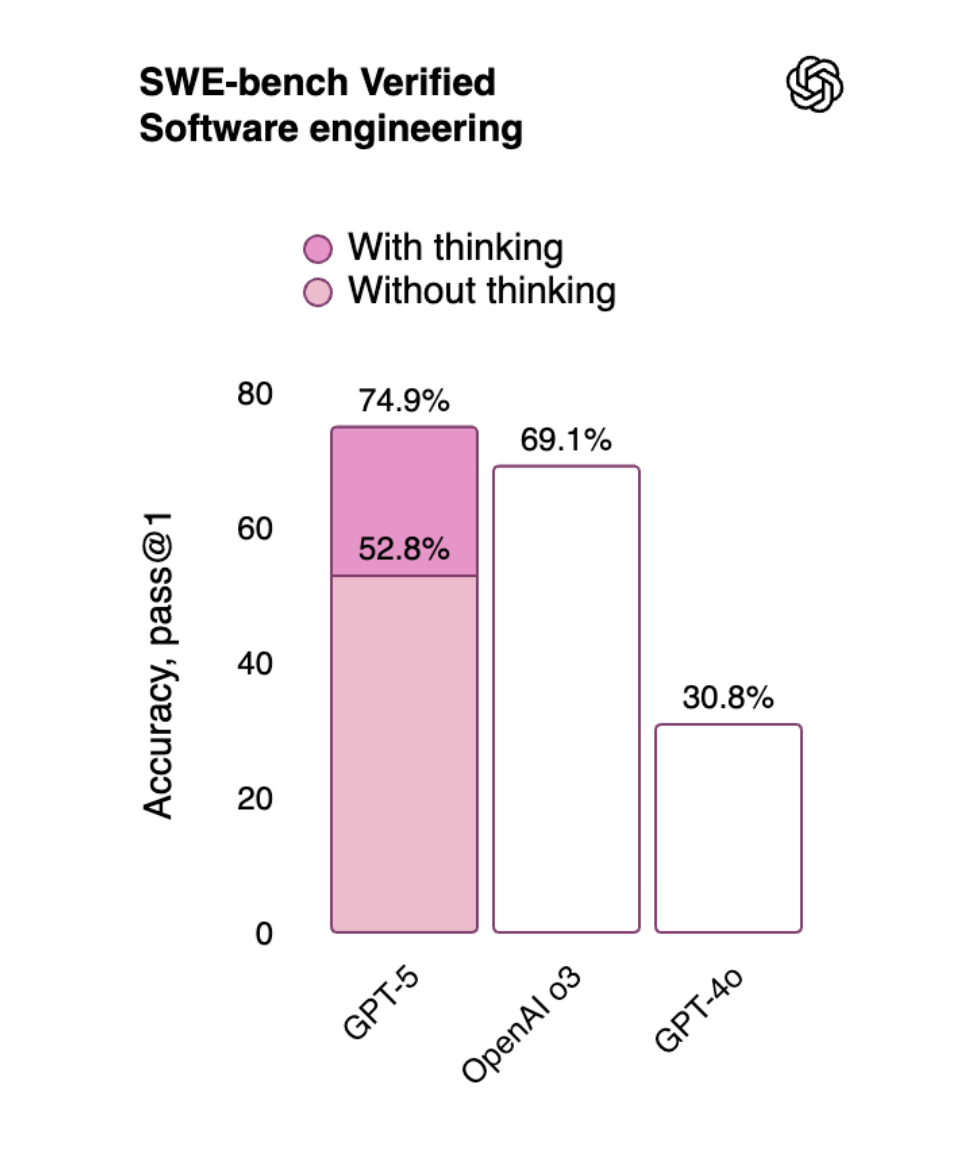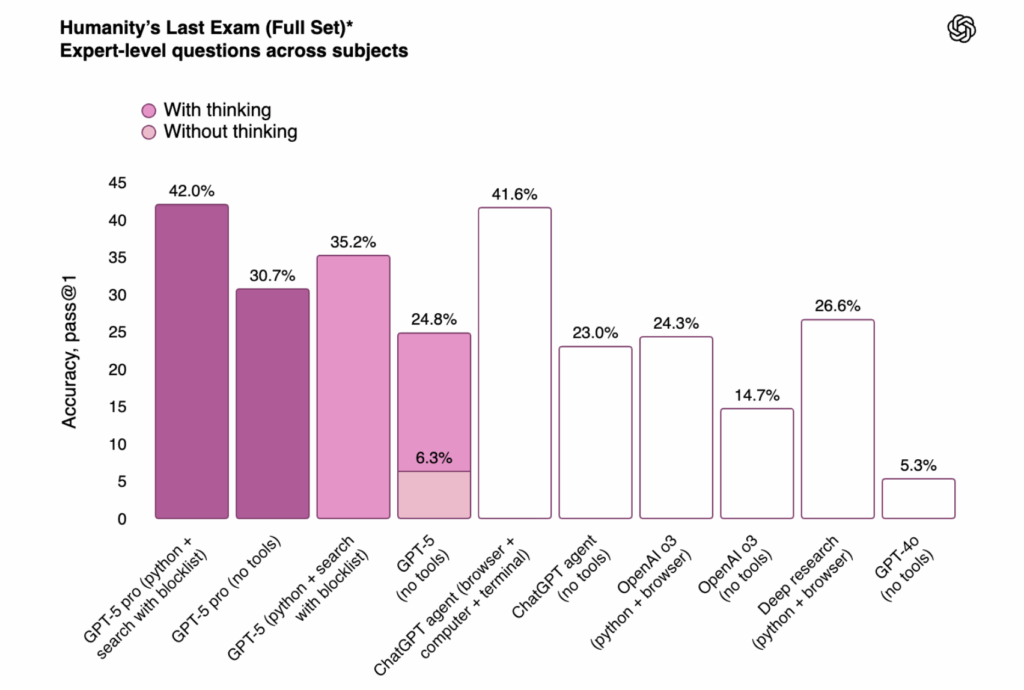
Credit: OpenAI / Benj Edwards
On Thursday, OpenAI announced GPT-5 and three variants—GPT-5 Pro, GPT-5 mini, and GPT-5 nano—what the company calls its "best AI system yet," with availability for some of the models across all ChatGPT tiers, including free users. The new model family arrives with claims of reduced confabulations, improved coding capabilities, and a new approach to handling sensitive requests that OpenAI calls "safe completions."
It's also the first time OpenAI has given free users access to a simulated reasoning AI model, which breaks problems down into multiple steps using a technique that tends to improve answer accuracy for logical or analytical questions.
GPT-5 represents OpenAI's latest attempt to unify its various AI capabilities into a single system. The company says the GPT-5 family acts as a "unified system" with a smart, efficient model that answers most questions, a deeper reasoning model called "GPT-5 thinking" for harder problems, and a real-time router that decides which approach to use based on conversation type, complexity, tool needs, and user intent. Like GPT-4o, GPT-5 is a multimodal system that can interact via images, voice, and text.
The rollout starts today, extending to ChatGPT's 700 million weekly active users, with varying usage limits based on subscription tier. Pro subscribers will receive unlimited access to GPT-5 and the GPT-5 Pro variant, while Plus users receive "significantly higher usage limits" compared to free users, according to a statement from OpenAI. GPT-5 Pro is replacing o3-pro in ChatGPT for those subscriber tiers with access to it.
Technical improvements and new features
Since the launch of GPT-4 in 2023, we've seen a trend of relative diminishing returns in terms of jumps in capability between major AI model releases. In that sense, the jump in contextual processing capability between GPT-3 and GPT-4 felt shockingly large. The jump between GPT-4 (if you consider the original 2023 version) and GPT-5 is still significant, but when you consider intermediate releases like GPT-4o, GPT-4.5, GPT-4.1, and o3-pro, GPT-5 feels like an incremental upgrade that is unlikely to shock anyone.
We've written about how OpenAI almost used the name "GPT-5" for models like o1 last year but decided to save it for a future release. Why these new models met that branding threshold is unclear, but the "GPT-5" name brand recognition will likely give OpenAI a boost in the public eye amid a heavily competitive industry.
Among the claimed improvements, OpenAI says GPT-5 delivers its "strongest coding model yet," achieving 74.9 percent on SWE-bench Verified and 88 percent on Aider Polyglot benchmarks. (To compare, earlier this week, Anthropic released Claude Opus 4.1, which reportedly scored 74.5 percent on SWE-bench.) GPT-5 can reportedly complete "complex coding tasks end-to-end with minimal prompting" and create software interface designs for users without coding experience.

A bar chart showing GPT-5's performance on the SWEbench coding benchmark provided by OpenAI.
Credit: OpenAI
For health-related queries, OpenAI positions, once again, GPT-5 as its "best model yet," scoring 46.2 percent on HealthBench Hard (a benchmark invented by OpenAI), though the company includes a disclaimer that "ChatGPT does not replace a medical professional." The model can reportedly help users understand medical results and prepare questions for health care providers, though it's best not to blindly trust the outputs of an AI model, because all AI language models, being predictive models tuned for user engagement, tend to tell people what they want to hear.
In other performance metrics, GPT-5 reportedly achieves 94.6 percent on AIME 2025 for mathematics without tools and 84.2 percent on MMMU for multimodal understanding. And with GPT-5 Pro's extended reasoning, it sets a new state-of-the-art on GPQA at 88.4 percent without tools. OpenAI claims GPT-5 with "thinking" performs better than OpenAI o3 with 50–80 percent lower output tokens across various capabilities.
GPT-5 reportedly shows significant improvements in accuracy. With web search enabled, GPT-5's responses appear to be around 45 percent less likely to contain factual errors (confabulations) than GPT-4o, and when "thinking," about 80 percent less likely to contain factual errors than o3. On long-form content benchmarks, GPT-5 with thinking shows about six times fewer confabulations than o3. Of course, AI models will fill in gaps in their "knowledge" using plausible-sounding information, so it's best not to rely on their outputs if you cannot check them yourself.

A bar chart showing GPT-5's performance on "Humanity's Last Exam," provided by OpenAI.
Credit: OpenAI
ChatGPT is also getting interface updates, including customizable chat colors, preset conversation "personalities" (with options like "Cynic," "Robot," "Listener," and "Nerd") that alter the system prompt, and integration with Gmail, Google Calendar, and Google Contacts for Pro users. The voice mode is being unified into a single "Advanced Voice" system that OpenAI says better understands user instructions and adapts its speaking style.
Meanwhile, the company's approach to response censorship has shifted with what it calls "safe completions." Rather than refusing requests outright, GPT-5 attempts to provide "the most helpful response as possible within safety boundaries," according to OpenAI's announcement. When the model cannot assist with a request, it provides explanations for its limitations.
OpenAI has also addressed previous issues with sycophancy. Earlier this year, an update to GPT-4o unintentionally made the model overly flattering or agreeable. Through new evaluations and improved training, GPT-5 has reportedly reduced sycophantic replies from 14.5 percent to less than 6 percent in targeted evaluations. Time will tell if this will help reduce the recent streak of triggering delusional and manic behaviors in some people.
We have not done much hands-on testing with GPT-5 yet but will likely evaluate its performance in more detail in a future article.
Developer access and pricing
For developers, GPT-5 comes in three API versions: gpt-5, gpt-5-mini, and gpt-5-nano, each offering different latency and cost trade-offs. The context window has expanded to 256,000 tokens, up from 200,000 in OpenAI's previous o3 model. Developers who require larger context windows can still use GPT-4.1 with its 1 million token capacity.
API pricing for GPT-5 is $1.25 per million input tokens with a 90 percent cache discount and $10 per million output tokens. It's somewhat comparable to GPT-4.1 ($2 input/$8 output per million tokens) and o3 ($2 input/$8 output per million tokens). GPT-5 Mini offers a more economical option at $0.25 per million input tokens and $2 per million output tokens, while GPT-5 Nano provides the most cost-effective but least-capable tier at just $0.05 per million input tokens and $0.40 per million output tokens. GPT-5 Pro pricing hasn't been announced yet for API access.
New developer features include "free-form function calling" that allows sending raw strings like SQL commands directly to tools without JSON formatting, verbosity controls for response detail, and "reasoning effort control" that lets developers toggle between fast responses and deeper analysis.
GPT-5 rollout details
The GPT-5 launch comes as OpenAI faces increasing competition from Google's Gemini models, Anthropic's Claude family, and Meta's open-weight Llama models. OpenAI reports having 5 million paying business users and 4 million developers building on its API platform.
GPT-5 replaces GPT-4o, OpenAI o3, OpenAI o4-mini, GPT-4.1, and GPT-4.5 as the default model for signed-in ChatGPT users. The system automatically applies simulated reasoning when responses would benefit from it, though paid users can still select "GPT-5 Thinking" from the model picker or add phrases like "think hard about this" to ensure reasoning is used.
The model begins rolling out on Thursday to all user tiers, with enterprise and education customers receiving access next week. OpenAI plans to retire its Standard Voice Mode within 30 days as part of the transition to the unified Advanced Voice system. Once free users reach their GPT-5 usage limits, they transition to GPT-5 mini, a smaller, faster model.

-
 C114 Communication Network
C114 Communication Network -
 Communication Home
Communication Home


